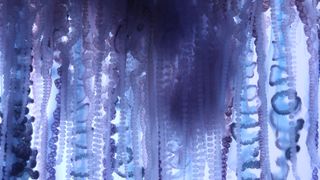Here's What Life Might Look Like on Another 'Strange Rock'
If humans ever find aliens, chances are that those otherworldly organisms will look nothing like us, but they may bear a closer resemblance to some of our simpler Earthly neighbors: microbes.
That's the idea discussed on a new episode of National Geographic's "One Strange Rock," in which astronauts explain why the search for extraterrestrial intelligence may be better off focusing on finding less-intelligent life-forms out in the universe.
We shouldn't expect to find "the bipedal character that looks very humanoid just walking through the door and saying, 'Hey, I evolved on a different planet, and there are a whole bunch of us around,'" retired NASA astronaut and physician Mae Jemison says in the episode. "But do I think simple life exists in other places? Absolutely." [The 6 Most Likely Places to Find Alien Life]

For most of Earth's 4-billion-year history as a life-sustaining planet, single-celled microbes were the only living things on our planet. Multicellular organisms like plants and animals only began to evolve some 600 million years ago. Homo sapiens have walked on Earth only for the past 300,000 years or so, and industrial civilizations have been around for only about 300 years.
If we define Homo sapiens as "intelligent," this means that intelligent life has been around for only about 0.008 percent of the time that life has existed on Earth. So, if the search for "intelligent" extraterrestrials were to focus on aliens that are as technologically advanced as we are, astronomers have a slim chance of finding those intelligent aliens, astronauts explain on tonight's episode of "One Strange Rock." However, the odds of finding microbial life and other simple organisms like algae and plants are much higher — as long as you're looking at the right exoplanets.
"The overwhelming probability, if you find a planet with life on it, it's probably going to be very simple life," retired NASA astronaut Jeff Hoffman says in the episode.
But even if astronomers were to discover an Earth-like exoplanet with primitive forms of life that follow a similar evolutionary path as life on Earth, those extraterrestrial creatures could still look very bizarre to people on Earth. For example, plants might not be green on other planets, Jemison explains, because they could have evolved to absorb and reflect different colors of light from a different type of star.
Get the Space.com Newsletter
Breaking space news, the latest updates on rocket launches, skywatching events and more!
To find out more about how life could evolve on other planets — and how complex life arose on Earth — tune in to "One Strange Rock" on the National Geographic Channel tonight (May 14) at 10 p.m. EDT/PDT (9 p.m. CDT).
Email Hanneke Weitering at hweitering@space.com or follow her @hannekescience. Follow us @Spacedotcom, Facebook and Google+. Original article on Space.com.
Join our Space Forums to keep talking space on the latest missions, night sky and more! And if you have a news tip, correction or comment, let us know at: community@space.com.

Hanneke Weitering is a multimedia journalist in the Pacific Northwest reporting on the future of aviation at FutureFlight.aero and Aviation International News and was previously the Editor for Spaceflight and Astronomy news here at Space.com. As an editor with over 10 years of experience in science journalism she has previously written for Scholastic Classroom Magazines, MedPage Today and The Joint Institute for Computational Sciences at Oak Ridge National Laboratory. After studying physics at the University of Tennessee in her hometown of Knoxville, she earned her graduate degree in Science, Health and Environmental Reporting (SHERP) from New York University. Hanneke joined the Space.com team in 2016 as a staff writer and producer, covering topics including spaceflight and astronomy. She currently lives in Seattle, home of the Space Needle, with her cat and two snakes. In her spare time, Hanneke enjoys exploring the Rocky Mountains, basking in nature and looking for dark skies to gaze at the cosmos.
